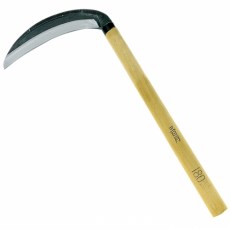Project Report For Gardening Scythe
Introduction
Project Report For Gardening Scythe Is As Follows.
A gardening scythe is an old agricultural implement that is used to chop grass, weeds, and other plants. It is made out of a long, curved blade connected to a handle that allows the operator to swing the blade in a sweeping motion to cut plants close to the ground. The scythe has been used for millennia and is still used today, especially in manual and organic agriculture. A gardening scythe’s blade is often made of steel and has a curved form similar to a sickle. It is honed on the inside edge for effective cutting. Longer blades are better for cutting wider areas, whereas shorter blades are better for manoeuvrability in confined places.
The handle of a scythe, known as a snath or snathe, is normally constructed of wood and is meant to give balance and control when in use. It is curved or inclined to assist the user to keep an upright position while cutting, decreasing pressure on the back and muscles. To operate a gardening scythe, the user grips the snatch with both hands and swings the blade in a rhythmic fashion, slicing through plants near to the ground. This cutting movement is efficient for cleaning huge areas fast and effectively, making the scythe a vital instrument for clearing overgrown fields, meadows, or garden plots.
One benefit of utilising a scythe in gardening is that it is environmentally friendly. It functions without the need of fuel or power, making it a sustainable and low-carbon tool option. The scythe is also silent in operation, allowing for tranquil gardening without disturbing the surrounding environment or adjacent wildlife. Furthermore, the scythe gives a certain amount of accuracy, allowing gardeners to precisely chop certain plants or parts of vegetation while leaving preferred plants or regions undisturbed. This control is very handy for controlling weeds or harvesting crops in a garden or field.

Types Of Gardening Scythe
Grass Scythe: This scythe has a long, thin blade that is particularly suited for cutting grass and thin plants. The blade is frequently straight or slightly curved, allowing for precision cutting close to the ground.
Bush Scythe: A bush scythe, also known as a briar scythe or thicket scythe, has a shorter and sturdier blade than a grass scythe. It is intended for cutting thicker and harder vegetation such as bushes, brambles, and woody plants.
Weed Scythe: Weed scythes are specialised scythes designed for clearing weeds and undesirable plants in gardens, walkways, and fields. They usually have shorter blades and frequently have serrated edges or unique teeth for better weed cutting.
Grain Scythe: Grain scythes have longer blades and are intended for harvesting cereal crops such as wheat, barley, or oats. The long blade allows for effective cutting of huge regions of standing crops.
Austrian Scythe: The Austrian scythe, also known as the European scythe, is a multifunctional scythe recognised for its ergonomic form. It has a long, curved blade and a lightweight, adjustable grip. Austrian scythes are well-known for their effectiveness and simplicity of usage.
Japanese Scythe (Kama): The Japanese scythe, or kama, is a classic agricultural instrument with a characteristic curved blade and a wooden handle. It is often used in rice farming, although it may also be used for general gardening and trimming.
Get Completely Custom Bankable Project Report
Market Potential Of Gardening Scythe
In 2022, the worldwide garden hand tools market is expected to be worth USD 18.52 billion. It is expected to reach USD 25.30 billion by 2031, increasing at a CAGR of 3.53% during the forecast period (2023-2031).
The market for gardening scythes is estimated to be modest in 2023. While the usage of scythes in gardening and agriculture has a long history, the market for manual cutting tools has grown more specialized in recent years owing to the availability and popularity of mechanised alternatives such as lawn mowers, trimmers, and power tools.
However, a segment of the gardening and farming community still cherishes the traditional and environmentally benign approach of using scythes. Organic gardeners, permaculture enthusiasts, and others who value low-carbon and environmentally beneficial practices are all welcome. Scythes are appealing to these folks due to their simplicity, quiet operation, and absence of reliance on fuel or power. Scythes are seen as a way for them to connect with nature while also lowering their environmental footprint and preserving a quiet and meditative gardening experience.

